I spent a few years in the 49th state while growing up, but for some reason never realized what a titanic place it is. Kind of ironic considering most things seem downright massive to a kid. Perhaps it’s because I lived near Anchorage, whose population is large enough (just shy of 300,000 inhabitants — 41% of the entire state tally!) to provide the look-and-feel of a major American city. It’s also blessed with temperate weather due to the comparatively low latitude and coastal location.
But that’s all on top. Truth to tell, once you get out of the “big city”, it quickly becomes clear that Alaska is a place of extremes. The mountains, the temperatures, the fuel and food bills, the natural resources, the isolation, the beauty, and of course the physical size of the state itself are larger-than-life. Even going to a restaurant was an exercise in extremes; one of our favorite joints was a steakhouse that served such a large slab of meat that if you could finish it, it was free. I never made it under that limbo stick.
Alaska has a lot in common with Texas, come to think of it. Big, wide open spaces, a thriving oil industry, and a proud, much-deserved reputation for self-reliance. Back when I lived there — the early-mid 1980s — there were plenty of Texans in the area because of the new pipeline which was bringing crude oil from the Northern Slope to Valdez for shipping to refineries in the lower 48. The locals always knew how to get a Texan’s goat: tell them that someday we’d split Alaska in two, thereby making Texas the third-largest state.
As I recall, they didn’t like that very much.
The early 80’s were a transitional time for southern Alaska. The population of Anchorage had grown by 263% over the previous decade and the area was still feeling the effects of such rapid expansion. Our little hamlet, Eagle River, doubled in size in less than five years, and the state was so flush with money that they instituted the Alaska Dividend, something which is best thought of as a reverse income tax. You’d get money — a percentage of the state’s oil revenue — simply for being a resident of Alaska. For an adult, the annual dividend check was more of a nicety than anything else, a small help in offsetting some of the high costs of living up there. But imagine being a 10 year old kid! It’s the early 80’s, you’re used to having nickles, dimes and quarters… and suddenly you’re getting a $1,000 check every year. “Score!!”
Like I said, a land of extremes.

Anyway, since I started flying the Gulfstream, I’ve been back to Alaska several times. Anchorage is a frequent “tech stop” for fuel before launching off to Asia. I’ve also done a pair of crew swaps in Nome, and most recently spent a few days in southeastern Alaska on a charter trip.
We were scheduled to fly into small fishing village near Juneau, but pre-flight planning determined that most of the instrument approach procedures in that part of the state had just been NOTAM’d as “Not Authorized”. An interesting turn of events, to say the least. Alaska’s weather more often than not dictates the use of an IAP to get on the ground when you’re flying a turbojet, but suddenly most of them were stripped away. The only one still available was a localizer approach which featured a DME arc and a 65 degree offset between the final approach course and runway.
This approach also featured my first live experience with the “inverse C” symbol on the Jepp chart. If you’re not familiar, this symbol indicates the use of new circling minimums for the procedure. I wrote about this several months ago, presciently noting that “increasing the circling radii will often have the effect of raising the Minimum Descent Altitude, and that could make the procedure less valuable.” In this case, our circling minimums were 3,100′ AGL, so we literally needed VFR conditions to land. As anyone who’s been to southeast Alaska will tell you, that kind of weather doesn’t occur too often in the region, and this day was no exception. Despite good visibility underneath the layer, we never broke out and after a textbook missed approach procedure, diverted to Sitka where the weather was VFR.

As the state’s fourth largest city, Sitka boasts a massive population of 9,000. Even a blind man would identify Sitka as a fishing town due to the persistent smell of fish throughout the area. It’s not unpleasant, especially when mixed with the scent of salt air, but is definitely a sign that you’re “somewhere else”.
The airport features something wholly unfamiliar to most pilots these days: an on-site Flight Service Station. I had to think long and hard to determine whether I’d ever even been inside one of them before. I believe the answer is “no”. The lone employee working the facility enlightened us about the area’s approach procedures; they were NOTAM’d out of service because the FAA discovered a magnetic variation in the state’s panhandle.

As if this wasn’t enough, that day the list of banned procedures had grown significantly, and now included most of the departure procedures. Apparently this was causing havoc with lifeguard flights because without those departures they needed VFR weather in order to take off. While I understand the significance of magnetic variations on some IAPs, it was frustrating to see the satellite-based procedures cancelled due to this phenomenon. Wouldn’t a NOTAM announcing the variation be sufficient?
I was motivated to ask this question after seeing Alaska Airlines 737s coming and going from airports in IFR conditions. A fueler told me that they have their own custom, FAA-approved instrument approach procedures. So while the air ambulances were grounded, the airline soldiered on without a care in the world. This suggests a “red tape” situation more than a serious problem with the approaches. It’s probably driven — like most things these days — by liability concerns. The FAA is responsible for the approaches we were flying, whereas Alaska Airlines is the accountable party for their procedures.

The next day, we repositioned the airplane to Petersburg, a short 100 nautical mile flight from Sitka. With only 2,800 residents, Petersburg is even smaller than Sitka, but differentiates itself from the latter with a strong Scandinavian character. The town was founded by Peter Buschmann, a Norwegian immigrant who started a cannery there in the 19th century. The village evolved into a successful fishing center due to the nearby LeConte Glacier icebergs, which provided a method of cooling the fish. Even today, it is one of the most successful fishing towns in that part of the world with huge hauls of salmon, halibut, black cod, king crab, tanner crab, and herring.
Petersburg is sometimes referred to as “Little Norway”, and boy does it look like it! In fact, I saw more Nordic flags than American ones on display in town while we were there. Every year on May 17th they celebrate Norwegian Constitution Day and hold an annual festival in honor of their Scandinavian heritage. Apparently they celebrate it longer and more boisterously than in Norway!

Alaskan towns are know for their high ratio of watering holes to inhabitants, but even by that metric, the folks in Petersburg know how to party! Perhaps it’s because the town sits on the northern end of an island which has no bridges to anywhere else and they have to make their own fun, but we were regaled with more than one story of legendary, alcohol-fueled hell-raising during the festival, including throwing an Alaska Airlines crew into the town jail just because they could.
As with many such towns in Alaska, boats and aircraft are every bit as important — perhaps even more so — than cars and trucks. Petersburg’s airport is much larger than one would expect for a town of that size. Even so, there was only one provider of Jet-A fuel: a helicopter operation run by a single employee. He answered the phones, flew the helicopter, did the maintenance, the whole works. Normally a Gulfstream is gassed up using a “pressure fueling” connection underneath the wing which transfers the fluid at a very high rate, but that wasn’t available here, so we had the not-unpleasant experience of fueling Alaska-style: with a traditional hose hoisted over the top of the wing through fuel caps that probably hadn’t been opened in 10 years.
Over-wing fueling is so rare that we weren’t even sure the fuel caps were unlocked, or where they key to unlock them might be. Thankfully we had no problem getting the caps open. Over-wing fueling is much slower than pressure fueling. We added a thousand gallons and it took at least an hour and a half to move the plane into position, add the Jet-A (at a rate of about 15 gallons per minute), and then reposition the aircraft to a dedicated concrete pad designed to hold something of it’s significant weight.

Our fueler was extremely friendly. In fact, everyone we encountered in Alaska was pleasant and helpful. The locals might not notice it, but coming from Southern California, it was clear as day to me since, sadly, we don’t always see that attitude down here. It was obvious that they take pride in their work and are always on the lookout for ways to help strangers. When we needed ice for the galley, a guy on the airport offered to drive me to the market. When we couldn’t find a ladder to check the fuel caps, there he was again, lending a hand and offering us a meal from the barbeque they were preparing outside their hangar.
The fueler was kind enough to not only do the grunt work of adding kerosene to our bird, but also offered to take us on a helicopter tour of the area since he had to reposition a logging crew from one place to another. Well we certainly weren’t going to say no to that!
After a quick meal in town, we returned to the airport and departed on a spectacular flight over Spirit Creek, Wrangall Narrows, Summer Straight, glaciers, and various other inner passages of southeast Alaska. It’s one thing to see sights like this from the flight levels, but quite another to watch them slide by from just a few hundred feet above the Earth. If you want to see things up close and personal, a jet is not the right tool for the job. When we’re down low in the Gulfstream it’s almost always because we are in the process of taking off or landing, so our sightseeing opportunities are rather limited.
Anyway, our intrepid pilot dropped us off in the midst of Tongass National Park, right next to a tiny U.S. Forest Service cabin on the edge of the Harding River. He zoomed away to move that work crew and left us free to explore the area for an hour or so. It’s moments like that that really make this job worth it. I looked around and couldn’t believe our good fortune. People pay thousands of dollars for the privilege of “getting away from it all”, and here I was being paid to do exactly the same thing!

That hour passed all too quickly. It seemed like just a few minutes before we heard the familiar sound of the rotorcraft’s blades beating the air into submission as our ride returned to pick us up. By this time the ceiling was down to 500′ overcast in light to moderate rain. Not something I’d typically fly VFR in. But then, this is Alaska, and we were in a helicopter, so it qualified as “better than average” conditions.
It was one of those perfect days. We had just enough time to head back to our hotel, grab a nap and shower, and return to the airport — a three minute drive — to prep the jet for a smooth, pleasant flight back to the “lower 48”. As we streaked across the sky, eight-and-a-half miles above the earth, I looked over my shoulder at the slowly setting sun and hoped I’d be headed back to the Last Frontier again soon.
Enjoy this gallery of photos from the trip:





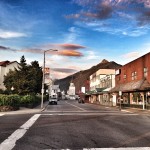


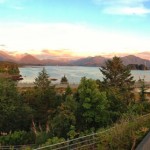
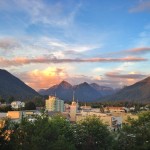

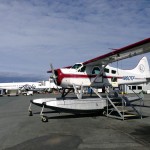

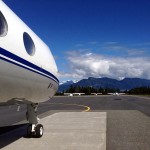


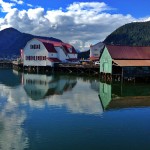

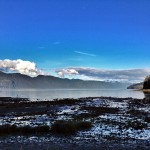
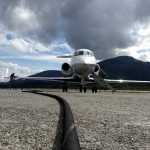
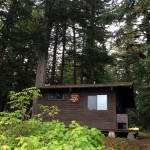

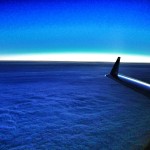





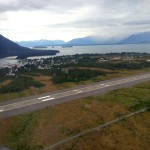
Lovely story Ron! I have yet to make it up to Alaska and after reading your account, I can’t wait until I do.
I can certainly see how folks are drawn to it.
Brent
Ron – Thanks for sharing your story and those great images! We cruised to Alaska about ten years ago and, while it was a great way to explore many of the natural wonders (at least those available near the inside passage), reading your account reinforced for how it insulated us from experiencing the people and culture.
I was also interested in your account of the NA instrument approaches. Did you hear anything about the long term plan for those? Considering the dependence of Alaskan towns on general aviation for supplies and transportation, it seems like this situation would be absolutely crippling.
The local aviation community and the FSS specialist I spoke to were both in the dark about details, but the assumption was that the procedures would be NA until they were re-published with the new magnetic data and then flight checked by the FAA. I’m not sure if they’re in the process of doing that as we speak, but I assume so. I just looked at the FDC NOTAMs for that part of the state. Some of the IAPs are still unavailable, but it appears to be a smaller list than when we went up there.
The cruise ships are interesting. Certainly a great way to see the state. In fact, the ONLY way to really see the finer points of the inside passage. They also bring in much-needed revenue and create jobs. On the other hand, I’d imagine they change the character of a small town when they’re in port. A city of 10,000 people that suddenly becomes a city of 15,000 undergoes a swift transformation! I’ve see this first-hand on Catalina Island in the city of Avalon. The streets quickly become packed with people. They they disappear a few hours later and you wonder what happened! 🙂
Thanks, Ron. I worked out of Sitka 1982-89, including a stint as a USFS fishery biologist doing stream surveys, so the “Killer Egg” 500D was a familiar vehicle for our morning and evening commutes. 1990-2011, I lived in Cordova on the north Gulf coast. We had NCL for a couple years, a 900-passenger cruise ship once a week in a town of 2,400! (Residents suspected dogs were included.)
I was fortunate to have been “tour group leader” (Wrangell Mountain Air’s label) in 2008 with a neighbor to run two DC-3 flights of passengers to McCarthy/Kennicott on an overnight excursion for Cordova’s centennial, reenacting the Cordova Airlines excursions of the late 1950’s. I’m a part of history… Aren’t we all?
We are indeed! Your air tour event sounds like it would have been a blast. Alaskan aviation is always an adventure. I’ve got a friend up there right now who’s always posting photos of him landing on the side of glaciers. What a life!
Great story. Great pics. I am GREEN with envy. Thanks a lot for sharing.
Ron, I did enjoy reading your article and the beautiful pictures. With 55 years in aviation working around the world I have seen some lovely places but Alaska is something special. I learnt to fly in tigermoths but kept flying as a hobby. I remember arriving at Anchorage for the first time by airline and seeing the llarge areas of car parks only to realise when we got lower that they are float plane parks – fantastic. I always wanted to add float planes to my PPL but never did, it always remained a dream. I love the idea of flying from lake to lake and fishing from the floats. My only concern would be the very large mosquitos which I experienced in Russia. I enjoy watching the TV programme – Flying Wild Alaska.
Aviation is a great industry bringing people of the world together. Aviation people are a great family, whereever you go you find friends.
You should go after that rating, Graham! It’s never too late. Besides, I’ve never heard anyone say a bad word about float flying. I’m rated but haven’t had much chance to put it to use. Those who do really seem to love it. A fellow CFI takes his Skyhawk out to Minnesota every year, converts the landing gear to straight floats, and spends the summer zipping around the countless lakes in that area. Always makes me #envious.
I’ve got a student who just emailed me about seeing Row 44’s Grumman Albatross land in Long Beach harbor, said it was the coolest thing he’s encountered in a long time and asked if I knew anything about it. I replied that he should call the company and ask them if he could see it in person somewhere or get a ride. Normally that would be crazy talk, but because it’s aviation, there’s probably a real chance he’ll be able to work it out.
Like you said, we’re a great family!
Thanks for sharing your adventures Ron!! I learnt more about Sitka through your blog. The oil industry in Alaska is likely to thrive in the years to come, considering the increase in investment by leading oil and gas companies in this area.
Great post, as usual!
Boy, I’m getting old, though: I remember going into the FSS at SNA back in the ’70s. YIKES!
I know how you feel. It’s equally hard for me to imagine SNA with a flight service station on-site! I don’t know how you guys did it without instant internet access to the latest weather reports and graphics. Heck, we’re so spoiled today that I usually don’t have to go without Internet even when I’m in the air. 🙂
Ron, I could have sworn I posted a comment on this, but I
guess better late than never! What a great way to return to your
routes…in a G-string! 😀 As you know, I spent a summer season
flying the bush out of PJNU (Juneau) back in the late 80’s. From
that comes my novel, “The Last Bush Pilots.” Needless to say, a big
chunk of my heart remains back there in Southeast Alaska! So,
hearing names like Sitka, Petersburg and Tongass gets my pulse
racing. Oh, and post a pic of a Beaver on floats…I just melt in a
pool of blubber, LOL! Thanks for the trip down memory lane…
Eric
Well-played, my friend — I’ve never heard the Gulfstream referred to as “g-string”! Glad I could provide a bit of nostalgia for the “good old days”; I can see why people love it up there, especially if you’re coming to it from the hustle and bustle of a large city. The natural beauty, peace, quiet, fresh air… it can be addicting. And it comes without the severity of the northern slope’s extreme climate.